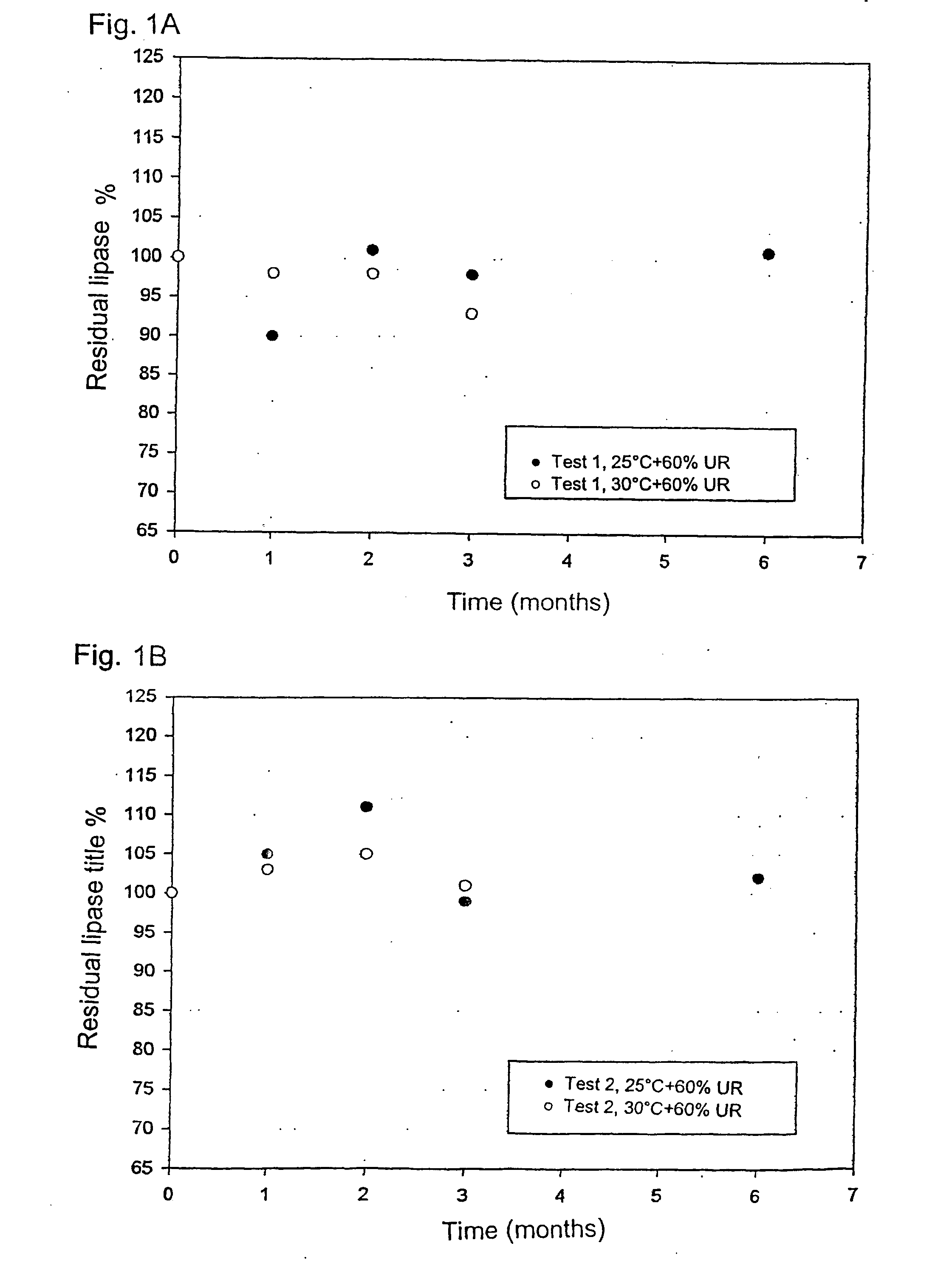Microspheres of pancreatic enzymes with high stability and production method thereof
a technology of pancreatic enzymes and microspheres, which is applied in the direction of immobilised enzymes, enzymes, non-active ingredients of pharmaceuticals, etc., can solve the problems of reducing the range of micronisation processes applicable to this product, affecting the pathology of affected foods, and unable to digest foods. , to achieve the effect of reducing the range of micronisation processes, reducing the range of applications of the micronisation process
- Summary
- Abstract
- Description
- Claims
- Application Information
AI Technical Summary
Problems solved by technology
Method used
Image
Examples
example 1 (
REFERENCE)
[0043] Preparation of Pancreatin Pellets through Powder Application On Inert Nuclei
[0044] In the basket of a fluid bed of the type Glatt GPCG-1 provided with rotor insertion (rotating disc) are placed 798.0 g of neutral pellets (type "non-pareil seeds", formed by saccharose and maize starch) having sizes between 250 and 350 .mu.m. The pellets are heated to 23.degree. C. by blowing warm air at 28.degree. C. The entering air speed is 1 m / sec for the process whole time. Separately the powdered pancreatin is mixed with 2.0% by weight of colloidal silica (Aerosil.RTM. V200) to improve its flow-ability. The entering air temperature in the fluid bed is increased to 54.degree. C. so that the pellets temperature is about 27-28.degree. C., and 490.0 g of said mixture are applied through a proportioning device Heton Feeder at a rate of 26 g / min, while simultaneously demineralized water is sprayed through a nozzle with a 0.8 mm hole and a flow rate of about 5-6 g / min. The filtering ho...
example 2 (
REFERENCE)
[0045] Preparation of Pancreatin Pellets through Extrusion-Spheronisation
[0046] 660.0 g of pancreatin, 2465.1 g of Avicel.RTM. PH101 (microcrystalline cellulose), 165.0 g of Kollidon.RTM. K30 (polyvinylpyrrolidone) and 9.9 g of Syloid.RTM. 244 (colloidal silica) are mixed in an 18 liters mixing cube at 18 rpm for 15 minutes. The mixture is fed through a co-rotating double screw extruder TSA EF 26-20. The cochlea of the feeding hopper is in position Ill, while the extruder cochlea is rotated at 125 rpm. Simultaneously a solution is fed including demineralized water and isopropyl alcohol in proportion 4:1 w / w by means of a peristaltic pump Watson-Marlow at about 20 g / min. The product is extruded with a 0.4 mm axial die. The total extrusion time is 102 minutes. Immediately after the extrusion, the product is spheronized with a spheronizer Glatt P-50 with rotating speed of 750 rpm for 3 minutes. The so obtained pellets are desiccated in thermostatic furnace at 35 .degree. C. f...
example 3
[0048] Preparation of Pancreatin Pellets through Direct Spheronisation in Fluid Bed
[0049] 680.0 g of pancreatin and 320.0 g of PEG400 (polyethylene glycol) are placed in the basket of a fluid bed Glatt GPCG-1 provided with Rotor insertion. The disc is of the knurled type and revolves at 1200 rpm, while simultaneously air is blown at 70.degree. C. at about 1-2 m / sec. The filter hoses are shaken for 5 sec any 6 sec. After 60 minutes spheronisation the entering air temperature is lowered to 20.degree. C. to obtain the hardening of the pellets, while the disc rotation keeps on at 700 rpm. In this stage the shaking of the filters is of 5 sec any 12 sec. After about 30 min cooling the product is unloaded from the basket of the fluid bed. The process total time is 90 minutes. The theoretical title of the pellets, calculated by the composition, was 40.12 U-FIP / mg. The obtained enzymatic title (lipase) was 38.12 U-FIP / mg, with an activity loss lower than 5%.
[0050] In all test the ponderal yi...
PUM
| Property | Measurement | Unit |
|---|---|---|
| diameter | aaaaa | aaaaa |
| diameter | aaaaa | aaaaa |
| diameter | aaaaa | aaaaa |
Abstract
Description
Claims
Application Information
 Login to View More
Login to View More - R&D
- Intellectual Property
- Life Sciences
- Materials
- Tech Scout
- Unparalleled Data Quality
- Higher Quality Content
- 60% Fewer Hallucinations
Browse by: Latest US Patents, China's latest patents, Technical Efficacy Thesaurus, Application Domain, Technology Topic, Popular Technical Reports.
© 2025 PatSnap. All rights reserved.Legal|Privacy policy|Modern Slavery Act Transparency Statement|Sitemap|About US| Contact US: help@patsnap.com

